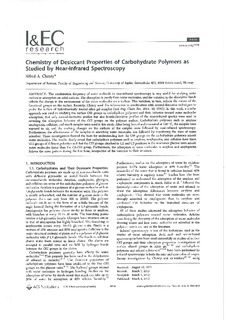| dc.contributor.author | Christy, Alfred A. | |
| dc.date.accessioned | 2014-05-07T08:19:11Z | |
| dc.date.available | 2014-05-07T08:19:11Z | |
| dc.date.issued | 2013 | |
| dc.identifier.citation | Christy, A. A. (2013). Chemistry of desiccant properties of carbohydrate polymers as studied by near-infrared spectroscopy. Industrial and Engineering Chemistry Research, 52(12), 4510-4516. doi: 10.1021/ie302199k | nb_NO |
| dc.identifier.issn | 0888-5885 | |
| dc.identifier.uri | http://hdl.handle.net/11250/194653 | |
| dc.description | Published version of an article in the journal: Industrial and Engineering Chemistry Research. Also available from the publisher at: http://dx.doi.org/10.1021/ie302199k | nb_NO |
| dc.description.abstract | The combination frequency of water molecule in near-infrared spectroscopy is very useful for studying water molecular adsorption on solid surfaces. The absorption is purely from water molecules, and the variation in the absorption bands reflects the change in the environment of the water molecules on a surface. This variation, in turn, reflects the nature of the functional groups on the surface. Recently, Christy used this information in combination with second-derivative techniques to probe the surface of hydrothermally treated silica gel samples (Ind. Eng. Chem. Res.2011, 50, 5543). In this work, a similar approach was used in studying the surface OH groups in carbohydrate polymers and their behavior toward water molecular adsorption. Not only second-derivative profiles but also fourth-derivative profiles of the near-infrared spectra were used in revealing the adsorption behavior of the OH groups on the polymer surface. Carbohydrate polymers such as amylose amylopectin, cellulose, and starch samples were used in this study. After being heated and evacuated at 120 °C, the samples were exposed to air, and the evolving changes on the surfaces of the samples were followed by near-infrared spectroscopy. Furthermore, the effectiveness of the samples in adsorbing water molecules was followed by monitoring the mass of water adsorbed. These investigations formed the basis for understanding how the OH groups on the carbohydrate polymers adsorb water molecules. The results clearly reveal that carbohydrate polymers such as amylose, amylopectin, and cellulose have three OH groups of different polarities and that the OH groups attached to C2 and C3 positions in the monomer glucose units adsorb water molecules faster than the C6-OH group. Furthermore, the adsorption of water molecules in amylose and amylopectin follows the same pattern during the first hour, irrespective of the variation in their structure. | nb_NO |
| dc.language.iso | eng | nb_NO |
| dc.publisher | American Chemical Society | nb_NO |
| dc.subject | VDP::Matematikk og Naturvitenskap: 400::Kjemi: 440 | nb_NO |
| dc.subject | VDP::Teknologi: 500::Kjemisk teknologi: 560 | nb_NO |
| dc.title | Chemistry of desiccant properties of carbohydrate polymers as studied by near-infrared spectroscopy | nb_NO |
| dc.type | Journal article | nb_NO |
| dc.type | Peer reviewed | nb_NO |
| dc.source.pagenumber | 4510-4516 | nb_NO |
| dc.source.volume | 52 | nb_NO |
| dc.source.journal | Industrial and Engineering Chemistry Research | nb_NO |
| dc.source.issue | 12 | nb_NO |
| dc.identifier.doi | 10.1021/ie302199k | |
